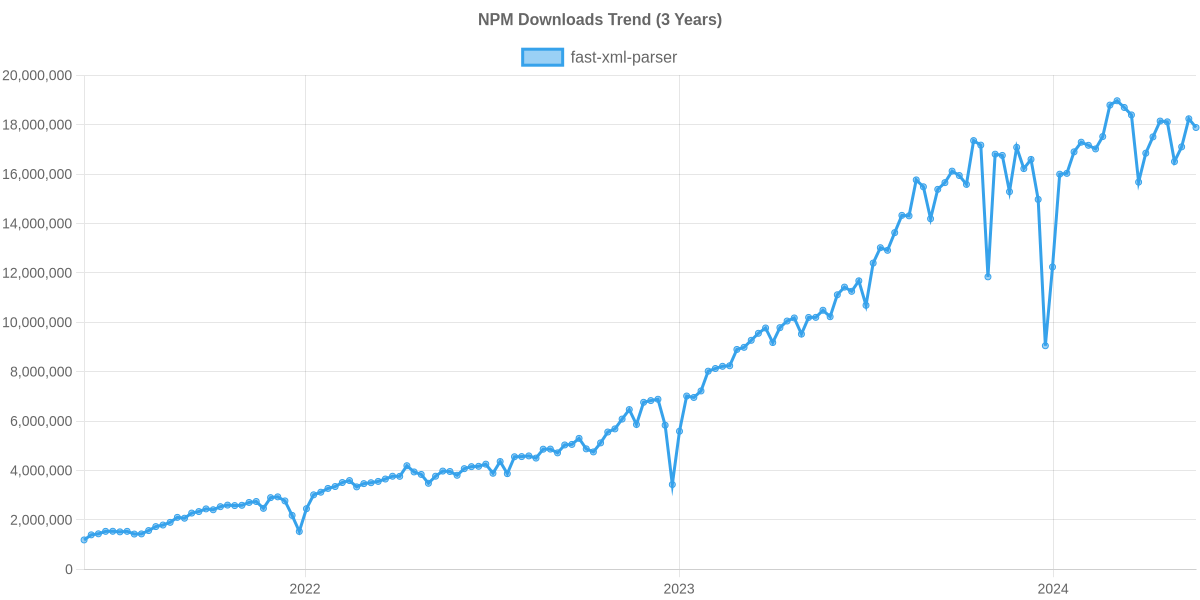Performance
- fast-xml-parser:
fast-xml-parser is optimized for speed, making it one of the fastest XML parsers available. It minimizes memory usage and processing time, which is crucial for applications that handle large volumes of XML data.
- xml2js:
xml2js is generally slower than fast-xml-parser but offers more flexibility and features. Its performance is adequate for most applications, particularly when parsing complex XML documents that require customization.
- xml-js:
xml-js provides a balanced performance suitable for smaller XML files. While not as fast as fast-xml-parser, it offers reasonable efficiency for typical use cases without extensive overhead.
- xmldom:
xmldom's performance is comparable to other DOM parsers, but it may lag behind specialized parsers like fast-xml-parser in raw speed. However, it excels in scenarios where DOM manipulation is necessary.
Ease of Use
- fast-xml-parser:
fast-xml-parser has a simple and intuitive API, making it easy to integrate into projects. It requires minimal setup and provides straightforward methods for parsing and converting XML.
- xml2js:
xml2js has a slightly steeper learning curve due to its extensive options and configurations. However, once understood, it provides powerful capabilities for XML parsing and customization.
- xml-js:
xml-js is designed for simplicity, offering a clear API for converting between XML and JSON. Its ease of use makes it an excellent choice for developers who need quick XML handling without a steep learning curve.
- xmldom:
xmldom follows standard DOM methods, which makes it familiar to developers who have experience with web APIs. Its usage is straightforward for those accustomed to working with DOM elements.
Flexibility
- fast-xml-parser:
fast-xml-parser is less flexible than some other libraries, focusing primarily on performance. It has limited options for customizing the parsing process, which may not suit all use cases.
- xml2js:
xml2js is highly flexible, allowing developers to customize parsing options extensively. It supports various configurations for handling attributes, namespaces, and more, making it suitable for complex XML scenarios.
- xml-js:
xml-js offers basic flexibility for converting XML to JSON and vice versa, but it lacks advanced features for complex XML structures. It is best for straightforward XML documents.
- xmldom:
xmldom provides flexibility through standard DOM manipulation methods, allowing developers to traverse and modify XML documents easily. It is ideal for projects that require extensive XML document handling.
Community and Support
- fast-xml-parser:
fast-xml-parser has a growing community and is actively maintained, ensuring that developers can find support and updates as needed. Its performance focus has garnered interest among developers looking for speed.
- xml2js:
xml2js has a large user base and extensive documentation, making it easy to find help and resources. Its popularity ensures that it is well-supported and regularly updated.
- xml-js:
xml-js has a smaller community but provides sufficient documentation and examples to help users get started. It is suitable for simple projects where extensive community support is not critical.
- xmldom:
xmldom benefits from being part of the broader DOM ecosystem, which has a large community. It is well-documented, and developers familiar with the DOM will find it easy to use.
Compatibility
- fast-xml-parser:
fast-xml-parser is compatible with Node.js and modern browsers, making it versatile for various environments. Its lightweight nature ensures it can be used in performance-sensitive applications.
- xml2js:
xml2js is primarily designed for Node.js but can be used in browser environments with some additional configuration. Its flexibility makes it suitable for server-side applications.
- xml-js:
xml-js is also compatible with both Node.js and browsers, providing a straightforward solution for projects that need basic XML handling across environments.
- xmldom:
xmldom is designed to be compatible with Node.js and provides a DOM-compliant interface, making it ideal for applications that require standard DOM manipulation.
























 * Y-axis: requests per second
* Y-axis: requests per second

